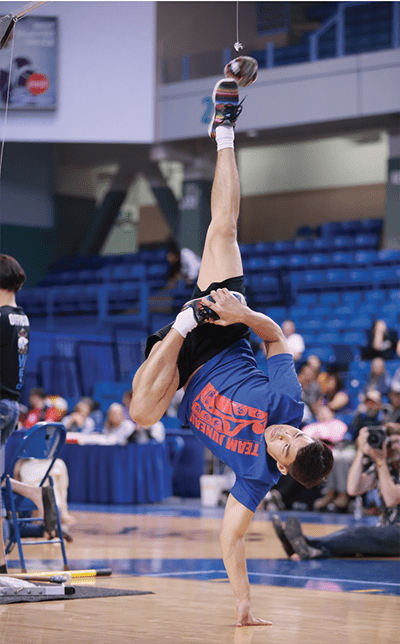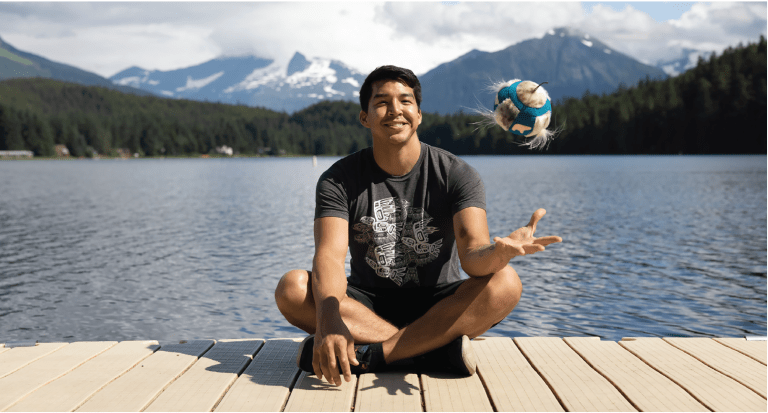Kyle Worl is an athlete and coach competing in the arctic sports category of this month’s Arctic Winter Games, being held in the Mat-Su valley. The arctic sports events, which originated over many generations in Indigenous communities across the circumpolar north, are a highlight of the games. They include the two-foot high kick, knuckle hop, and other sports linked to Indigenous hunting skills. The Arctic Winter Games also host competitions in hockey, skiing, skating, and other sports.
Worl is a decorated Tlingit athlete who lives and coaches in Juneau. He has competed in arctic sports for over 15 years and first joined the Arctic Winter Games in 2014.
Why are arctic sports such a highlight of the games?
They’re unique to the north and I think the sport is growing in popularity. I think what a lot of people enjoy is learning how the games connect to the culture and history of Alaska and the Inuit, Inupiaq, and Yup’ik people. They’re not just games. They reflect what it took to survive in the north long ago. Hunters used them to build overall fitness, coordination, balance, and strength. Some of the games also incorporate hunting techniques like the knuckle hop, seal hop, and stick pulls. They’re physically and mentally challenging, and they all have a story behind them.
Do the athletes connect to those stories?
That’s a huge part of what the sport is about. The origins of arctic sports are from the northern communities, but all Indigenous groups have been subsistence hunting people, so I think the games resonate for any Indigenous participant. And for non-Indigenous people, too. There’s a strong sense of community in the sport, and that comes from our Native values of working together for survival. I think anyone is drawn to that sense of community.
Are you excited that the Arctic Winter Games are back in Alaska for the first time in a decade?
Yeah, the first time I participated was in 2014 in Fairbanks. It was a huge achievement. I was originally an alternate and ended up getting on the team. It was a life-changing experience to be part of an event that brings together Arctic nations and celebrates our cultures. Now with it back in Alaska 10 years later, I can look back at a career and reflect on my growth.
How does coaching compare to competing as an athlete?
Coaching is a huge shift. You go from being a young athlete focused on your own performance to now supporting the entire team and providing not only technical coaching but also positive reinforcement and emotional support. Events like Arctic Winter Games can be stressful. It’s a week-long event. You’re sleeping together, competing every day, and representing your community. But you can’t have a personal record every day. It can feel intimidating at times, but it’s also something that uplifts you. As a coach you have to help manage those emotions.

What is it like to compete with teams from across the Arctic?
The traditional games that arctic sports are based on were played across the circumpolar north, from Russia, Alaska, Canada, Greenland, spanning thousands of miles. Before European contact, Indigenous people were able to freely move and meet with other communities. But today there are political borders that create challenges for us to maintain those connections that we’ve had for thousands of years. So the games reconnect northern people in celebration of culture and sports.
It’s one of my favorite things about it. I can go and meet athletes from Greenland, from Russia, from Canada, and we can see the connection between us. There are sometimes language barriers but we understand the games and can communicate through them. That’s something powerful that any participant takes away, that connection to a broader global community. And helping to reestablish ties that have existed for thousands of years.
Do the athletes gain confidence and skills they can use beyond the games?
Arctic games—or in the Alaska K-12 level it’s called Native Youth Olympics—is a premier event. If this was basketball, it would be the NBA. That’s what you dream about and strive for. So to participate is a huge confidence boost. You come back with a greater sense of your own self. Because you see, hey, I’m not just here to represent myself but I’m representing my community, my state of Alaska, and the United States, since we’re the only state that participates in the games. You come away with a different sense of yourself as part of something bigger.
At Arctic Winter Games, everyone is sharing who they are and where they’re from. I remember after my first games I wanted to learn more about my own Native language, more about my culture so that the next time I compete I can share who I am and where I come from with more confidence. That potential for personal growth is an aspect that people don’t always realize when they first compete.
Check out coverage of the Arctic Winter Games at www.awg2024.org.
Top photo: Kyle Worl at Auke Lake in Juneau. Photo courtesy Kerry Tasker


Comments are closed.